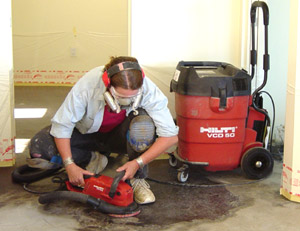 |
|||||||
| June 8, 2004
In This Issue of The Acid Staining Newsletter Chip and Thumper
This is a nifty walk-behind machine with an eight inch-wide blade mounted at floor level which chisels rapidly forward and back. It must be perfect for removing ceramic tile set in Thinset. It performed quite well on the polyurethane sealer, but the blade became dull after we had cleaned only two square feet, flakes of sealer and stain were flying everywhere, it was noisy and it took us two hours to clean a tiny section of floor. Next, we had to scrub away the oil residue left in the slab from the wood stain. Our acid stain kept rolling around on the slick surface. Several etchings with plain acid-water were required to create some tooth for our new stain and sealer. At this time I happened to attend a Home Builder's Conference and met an old friend - a commercial painting contractor - who began boasting to me about the miraculous dustless grinder he had just purchased. He claimed it could remove almost any sealer or paint layer from a floor with its flat diamond grinding wheels, created little dust, and had grinding heads so fine that no whorl-mark pattern would be left behind on the floor. The next day a representative of the Hilti Co. (1-800-879-8000/ www.us.hilti.com) came to our jobsite to demonstrate his machine. The grinding wheel was only about six inches in diameter and the operator had to lean over the tool on his hands and knees wearing a dust mask and use a constantly moving, circular motion. It cleaned the floor so smoothly and completely, though, that it seemed a miracle to us all. It also created very little dust, since the machine was hooked up to a wonderfully efficient vacuum with a self-cleaning filter. Every few minutes the vacuum would let out a loud "thump!" as it whacked its filter against the inside of the housing to knock loose the dust and let it drop to the bottom of its disposable bag. My crew christened the grinder "Chip" and the vacuum, which rolled along behind it, "Thumper." In ten minutes the crew concluded that this machine was exactly what we needed for the job. Unfortunately, the Hilti Company will not rent out or lease these tools. There remained the small problem of price. The Thumper and Chip combo retails for $3500 and each diamond wheel we used would be $500 (they can become dull after grinding one or two thousand square feet). I did some quick figuring and decided that this large job would cover the cost of the dustless grinder and greatly improve the morale of my crew.
Even with Chip and Thumper it took my crew eight days to clean 1600 square feet of floor. No one worker could bear to operate the grinder for more than an hour, so they took turns. After that, it was a simple matter to acid stain the floor with black and dark brown stains to achieve the dark (and very impractical) color the owner of the building desired. We sealed the floor with two coats of Elite Crete's AUS-50 (a naphtha-based acrylic sealer), let it gas off for 36 hours, and top-coated with two layers of On an' On Wax by Spartan Chemical Company. The building's owner-an extremely particular person-was satisfied. Time is running out! I would like to remind everyone that Monday June 14 will be the last day to reserve your spot in my upcoming 2004 Creating Fabulous Floors Seminars at the early bird price. If you would like to get this hands on training please don't delay in reserving your space. After June 14 the price will go up and you will lose the significant discount. This is the last time I will offer this course for several months at least, so if you are interested in attending don't put it off. Space is already filling up fast (especially for the Fundamentals portion). Go to the webpage below for more information on seminar content and registration details. http://www.acidstainconcrete.com/seminar If you prefer, call my publisher Bridgeworks at 1-888-514-1400 and they'll be happy to answer your questions. Happy Staining! GG Questions or comments about my newsletter? |
|||||||
|
|
|||||||


